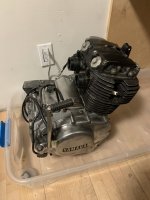BigMacDouble
XS400 Enthusiast
Hey there ,
this might be a pretty dumb question. As you might notice from my other posts I’m pretty new to the world of motorcycles.
I got a little too hasty and joined the crankcases before I had my hands on a torque wrench . Only after I had the entire engine finished did I remember I left the big end bearing bolts completely loose since I was going to tighten them when I got the wrench.
I’d prefer not to take the entire thing apart again . I’m thinking if I split it the crank will lift off with the top and cylinders and I can access the bolts . Am I missing something that makes this impossible? Or could this lead to damage maybe from the cam chain holding the weight of the crank?
Any advice would help!
this might be a pretty dumb question. As you might notice from my other posts I’m pretty new to the world of motorcycles.
I got a little too hasty and joined the crankcases before I had my hands on a torque wrench . Only after I had the entire engine finished did I remember I left the big end bearing bolts completely loose since I was going to tighten them when I got the wrench.
I’d prefer not to take the entire thing apart again . I’m thinking if I split it the crank will lift off with the top and cylinders and I can access the bolts . Am I missing something that makes this impossible? Or could this lead to damage maybe from the cam chain holding the weight of the crank?
Any advice would help!

